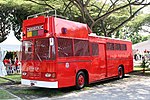Commonwealth MRT station

Commonwealth MRT station is an above-ground Mass Rapid Transit (MRT) station on the East West line in Queenstown, Singapore located at Commonwealth Avenue near the junction of Commonwealth Drive. The station serves the residential neighbourhoods of Commonwealth and Tanglin Halt. The station is in the vicinity of schools such as New Town Primary School, CHIJ Kellock, Faith Methodist Church, and Queensway Secondary School. The residential estates and station bearing the same name were named after Commonwealth Avenue built around 1963, which in turn was named after the British Commonwealth of Nations. Commonwealth station is a transport node for residents in the vicinity of Commonwealth Avenue, serving adjacent schools, places of worship, housing developments and businesses.
Excerpt from the Wikipedia article Commonwealth MRT station (License: CC BY-SA 3.0, Authors, Images).Commonwealth MRT station
Commonwealth Avenue, Singapore Queenstown
Geographical coordinates (GPS) Address Nearby Places Show on map
Geographical coordinates (GPS)
| Latitude | Longitude |
|---|---|
| N 1.3025583333333 ° | E 103.798225 ° |
Address
Commonwealth Avenue 375
149735 Singapore, Queenstown
Singapore
Open on Google Maps







